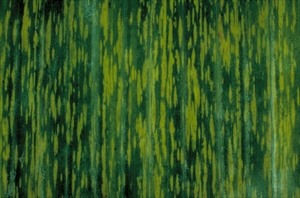Banana streak, banana streak disease
Pacific Pests, Pathogens, Weeds & Pesticides - Online edition
Pacific Pests, Pathogens, Weeds & Pesticides
Banana streak disease (215)
Banana streak badnavirus. Several strains have been recognised, and some of these are now considered to be distinct viruses.
Asia, Africa, North, South and Central America, the Caribbean, Oceania. Strains of Banana streak virus have been recorded from Cook Islands, Fiji, Guam, Papua New Guinea, Samoa, Tonga, Vanuatu, and Wallis and Futuna.
Banana and plantain varieties.
Symptoms vary depending on the strain of the virus, the variety of banana or plantain and the environment. The most common symptom is lines of yellow that run from the midrib of the leaf to the margin. These streaks are continuous or broken, and either scattered throughout the leaf or in bands. As the leaf ages, the streaks turn brown or black (Photos 1&2). Initially, the symptoms are similar to Cucumber mosaic virus (see Fact Sheet no. 100).
Infected plants may be smaller than normal and less vigorous, with smaller bunches.
In some African countries, dieback and internal rotting of the pseudostem occurs. Differences between symptoms in different parts of the world led to them being described as distinct viruses. Molecular studies on the DNA of the viruses have confirmed the differences.
Spread of the virus is in planting material, suckers primarily. Spread can also occur as plants in tissue culture if they are not tested properly. It is now known that the virus or parts of the virus can enter the DNA of certain varieties (e.g., AAB, ABB, AAAB types) and remain hidden there without showing symptoms. However, if bananas are grown under stress, such as occurs when they are growing as tissue cultures, the virus reassembles, multiplies, and symptoms appear.
Spread between plants is by mealybugs, especially species of Planococcus and Pseudococcus, although how important they are is not well known.
The damage caused to banana production varies considerably between varieties depending on their response to the various strains that exist. There is also the fact that symptoms disappear and reappear during the growth cycle. For many varieties yield loss is related to the intensity of infection at flowering and fruit filling.
In Australia, Banana streak virus is mostly of minor importance in Lady Finger (AAB) and Cavendish varieties, although some reports suggest losses of 6% annually, and delays in harvest. By contrast, high losses have been reported in Cavendish clones from some countries of West Africa and also South and Central America where there are strains that cause internal rots, split pseudostems, and plant death.
Look for the yellow lines that develop on the leaves, turning brown or black with age. Detection of the virus in plants is complicated by the fact that pieces of the virus can be inserted into the DNA of banana chromosomes. The so-called 'integrated' pieces of the virus are in addition to the virus that exists and multiplies in the banana cells, and is spread by mealybugs. However, molecular techniques are available that can differentiate between these two types of the virus, that which is integrated and that which is in the cytoplasm.
BIOSECURITY
Because of the presence of banana streak and other viruses, banana plants moved internationally should follow the latest version of the FAO/IBPGR Technical Guidelines for the Safe Movement of Germplasm. No. 15. Musa. 2nd Edition, (http://www.bioversityinternational.org/uploads/tx_news/Musa_spp.__2nd_edition__502.pdf). These Guidelines also suggest the length of time that plants should be held in quarantine under observation:
CULTURAL CONTROL
- Use only virus-free planting material, taking it from plantations that are free from banana streak disease.
- Regularly monitor plantations and remove diseased plants as soon as they are seen. Take them out of the plantation and burn them. Replace with disease-free plants.
CHEMICAL CONTROL
Use white or horticultural oils, or soap solution on banana plants infested with mealybugs (see Fact Sheet no. 56).
White oil:
- 3 tablespoons (1/3 cup) cooking oil in 4 litres water
- ½ teaspoon pure hand soap, not detergent
- Shake well and use.
Soap:
- Use soap (pure soap, not detergent):
- 5 tablespoons of soap in 4 litres water.
Commercial horticultural oil can also be used. White oil, soap and horticultural oil sprays work by blocking the breathing holes of insects causing suffocation and death. Spray the undersides of leaves; the oils must contact the insects. A second application of soap or oils may be necessary after 3-4 weeks.
____________________
When using a pesticide, always wear protective clothing and follow the instructions on the product label, such as dosage, timing of application, and pre-harvest interval. Recommendations will vary with the crop and system of cultivation. Expert advice on the most appropriate pesticides to use should always be sought from local agricultural authorities.
AUTHOR Grahame Jackson
Information from Diseases of fruit crops in Australia (2009). Editors, Tony Cooke, et al. CSIRO Publishing; and from CABI (2020) Banana streak disease. Crop Protection Compendium.(https://www.cabi.org/cpc/datasheet/8548. Photos 1&2 Kohler F, et al. (1997) Diseases of cultivated crops in Pacific Island countries. South Pacific Commission. Pirie Printers Pty Limited, Canberra, Australia.
Produced with support from the Australian Centre for International Agricultural Research under project PC/2010/090: Strengthening integrated crop management research in the Pacific Islands in support of sustainable intensification of high-value crop production, implemented by the University of Queensland and the Secretariat of the Pacific Community.





